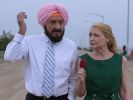Eye For Film >> Movies >> Learning To Drive (2014) Film Review
Learning To Drive
Reviewed by: Anne-Katrin Titze

Daytime hallucinations could be really scary. We are not exactly going into Nicolas Roeg's Don't Look Now territory in Venice with Donald Sutherland's search for Julie Christie, however, Isabel Coixet's Learning To Drive, with Patricia Clarkson and Ben Kingsley, creates a certain amount of space for the perplexing workings inside people's heads as it does for the New York City traffic outside.
One fateful night, a man rushes out of a restaurant and into a taxi. A woman, obviously angry and hurt, runs after him, shouting for the driver to wait for her. A split second decision to listen to the woman, not the man, changes their lives.

Yes, the backseat of a taxi is the perfect place to confront the husband of 21 years (Ted, played by Jake Weber), who is leaving his wife (Clarkson's Wendy) for the "third seven-year-itch" as she will at one point call it. Wendy skewers his cowardly decision to split up with her in a restaurant, a public place; and thus, very elegantly, the audience, which at this point includes the taxi driver, Darwan (Kingsley), knows everything needed to jump into the story.
Questions of fate and chance enter on tiptoes. Coixet has her actors anchored in concrete anger and captivating humor. Sarah Kernochan's screenplay is precise and doesn't shy away from the real-life absurdities we all encounter. Learning To Drive is based on an essay in Katha Pollitt's Learning To Drive: And Other Life Stories.
Wendy, in order to be able to visit her daughter, Tasha (Grace Gummer), in Vermont, decides it is time to get her driver's license. Darwan, originally from India and a devout Sikh, becomes her driving instructor. That the film was shot on location in New York City, adds to the overall feel of veracity. During the often adventurous drives through Manhattan and beyond, Wendy and Darwan learn a great deal about and from each other. Both their worlds open up a bit wider.
He compares the fact that she thought her husband would always be doing the driving, to his own infantile belief that his mother [in India and now dead] would always be doing the cooking for him. Meaning breaks in waves. Nothing is predictable where it matters and yet everything makes sense. The brilliant editing by Thelma Schoonmaker keeps catching us by surprise, the way dreams tend to delude us in moments of great distress.
During the second driving lesson, Wendy is furious when two guys start harassing Darwan, calling him Osama. It happens all the time, he tells her, and suggests that now might be a good time to discuss "road rage". Kingsley's performance breathes thought. His face reveals a man who thinks a hundred things at once and at times decides to put aside what is right in front of him.
Clarkson expertly maneuvers Wendy's terrors of learning to drive as well as re-learning to live her life. The giddiness and the rage make for a striking combination. Wendy has an anxiety attack when crossing the bridge from Manhattan to Queens. Darwan's calm voice reminding her that "it's just another road, only it is the sky" doesn't comfort her.
Darwan is awaiting the arrival of his wife to be, Jasleen (Sarita Choudhury). It is an arranged marriage and the two of them have never met before. Preet (Avi Nash), his cousin, helped during the matchmaking while having immigration problems of his own. The Grimms' fairy tale of The Wolf And The Seven Little Kids may come to mind when we see him hide in order to stay in the country.
"I am that house," protests Wendy when she finds out that she will have to sell their family house and look for a new apartment. How relative trouble is, and that the decision between "light or space", suggested by the real estate agent, is already quite a luxury, becomes clear when we see how Darwan and Jasleen live - underground and crammed in. Choudhury shows us a wonderfully nuanced woman for whom everything is alien in her new country with a stranger for a husband and a language she does not speak. What could so easily have stumbled into cliché turns into a study of overcoming cultural and personal obstacles with humour and grace.
Jasleen's trip to the 99 cent store to purchase a female necessity and the fact that she ends up involuntarily learning Spanish from a TV show highlight Coixet's skills as a director and a great heart. She so obviously cares about her characters, especially the women, and reserves some Schadenfreude for those who deserve it.
A scene involving a seduction attempt with a forest green pencil skirt, an uncomfortable laugh, a tow truck and a closed door is a skillful reminder that little sins are punished immediately. Learning To Drive revels in wicked ingredients and piles them on in clusters, such as a surprise date that includes French boasting, tantric yoga, some effective flattery and a spoonful of orange sorbet, the combination of which leads to one of Clarkson's most gymnastic scenes.
"The trouble is, you're a good man," Wendy concludes as being the emotional dilemma she finds herself in, when a new chapter in her life kicks into gear. Darwan, the "good man", knows that marriage for him, as a good Sikh, is "to be one spirit", which is easier said than done. "I can't talk to her. She is not educated. She is scared of America. She hides." Wordsworth poems for a bride who doesn't speak the language? Darwan is obviously and defiantly aware that the book is for himself and another. The truth is out there. It doesn't need to be expressed in words or bold gestures to be understood.
Reviewed on: 20 Aug 2015
















